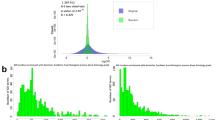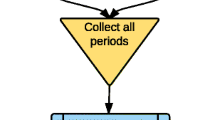Abstract
Cells regulate functionally related genes cis- and trans-contacts in order to perform specific biological roles. To understand the cryptic spatial genomic contexts underlying these biological functions, we analyzed the gene association data from the gene ontology (GO) database and the genomic spatial organization data obtained by analysis of chromosome conformation capture (3C)-based data from the Sequence Read Archive, where GO and 3C-based data were used to measure functional similarity and spatial proximity, respectively, between genomic loci. In the human genome and the fission yeast genome, we observed that correlation between the two measures was statistically significant on a genome-wide scale. Specifically, it is also confirmed that the genomic spatial architecture is affected by functional similarity of genes by showing better correlation of functional similarities with spatial distances estimated by contact frequencies than those estimated by genomic distances for cis-contacts. Furthermore, we analyzed distances between the genomic segments sharing the same GO term using the two-sample t test, found that the genomic segments identified by various GO terms are spatially located closer than the average distance over statistically-valid contacts, and provided a list of the GO terms. The results suggested that genomic loci with similar biological functions are situated in close proximity to each other in the nuclear space by aggregating functionally related genes in a short spatial range.




Similar content being viewed by others
References
Ashburner M, Ball CA, Blake JA, Botstein D, Butler H, Cherry JM, Davis AP, Dolinski K, Dwight SS, Eppig JT (2000) Gene ontology: tool for the unification of biology. The Gene Ontology Consortium. Nat Genet 25:25–29
Beissbarth T, Speed TP (2004) GOstat: find statistically overrepresented gene ontologies within a group of genes. Bioinformatics 20:1464–1465
Chagoyen M, Carmona-Saez P, Gil C, Carazo JM, Pascual-Montano A (2006) A literature-based similarity metric for biological processes. BMC Bioinform 7:363
Chang CW, Cheng WC, Chen CR, Shu WY, Tsai ML, Huang CL, Hsu IC (2011) Identification of human housekeeping genes and tissue-selective genes by microarray meta-analysis. PLoS ONE 6:e22859
Cremer T, Cremer C (2001) Chromosome territories, nuclear architecture and gene regulation in mammalian cells. Nat Rev Genet 2:292–301
Diament A, Pinter RY, Tuller T (2014) Three-dimensional eukaryotic genomic organization is strongly correlated with codon usage expression and function. Nat Commun 5:5876
Dice LR (1945) Measure of the amount of ecologic association between species. Ecology 26:297–302
Dixon JR, Selvaraj S, Yue F, Kim A, Li Y, Shen Y, Hu M, Liu JS, Ren B (2012) Topological domains in mammalian genomes identified by analysis of chromatin interactions. Nature 485:376–380
Duan Z, Andronescu M, Schutz K, McIlwain S, Kim YJ, Lee C, Shendure J, Fields S, Blau CA, Noble WS (2010) A three-dimensional model of the yeast genome. Nature 465:363–367
Ethier SD, Miura H, Dostie J (2012) Discovering genome regulation with 3C and 3C-related technologies. Biochim Biophys Acta 1819:401–410
Fraser P, Bickmore W (2007) Nuclear organization of the genome and the potential for gene regulation. Nature 447:413–417
Fullwood MJ, Liu MH, Pan YF, Liu J, Xu H, Mohamed YB, Orlov YL, Velkov S, Ho A, Mei PH (2009) An oestrogen-receptor-alpha-bound human chromatin interactome. Nature 462:58–64
Glass CK, Rosenfeld MG (2000) The coregulator exchange in transcriptional functions of nuclear receptors. Genes Dev 14:121–141
Gondor A, Ohlsson R (2009) Chromosome crosstalk in three dimensions. Nature 461:212–217
Hahn S, Kim D (2013) Physical origin of the contact frequency in chromosome conformation capture data. Biophys J 105:1786–1795
Hahn S, Kim D (2015) Identifying and reducing systematic errors in chromosome conformation capture data. PLoS ONE 10:e0146007
Hsiao LL, Dangond F, Yoshida T, Hong R, Jensen RV, Misra J, Dillon W, Lee KF, Clark KE, Haverty P (2001) A compendium of gene expression in normal human tissues. Physiol Genom 7:97–104
Hu M, Deng K, Selvaraj S, Qin Z, Ren B, Liu JS (2012) HiCNorm: removing biases in Hi-C data via Poisson regression. Bioinformatics 28:3131–3133
Huang DW, Sherman BT, Lempicki RA (2009) Systematic and integrative analysis of large gene lists using DAVID bioinformatics resources. Nat Protoc 4:44–57
Imakaev M, Fudenberg G, McCord RP, Naumova N, Goloborodko A, Lajoie BR, Dekker J, Mirny LA (2012) Iterative correction of Hi-C data reveals hallmarks of chromosome organization. Nat Methods 9:999–1003
Janga SC, Collado-Vides J, Babu MM (2008) Transcriptional regulation constrains the organization of genes on eukaryotic chromosomes. Proc Natl Acad Sci USA 105:15761–15766
Johnson DS, Mortazavi A, Myers RM, Wold B (2007) Genome-wide mapping of in vivo protein-DNA interactions. Science 316:1497–1502
Kalhor R, Tjong H, Jayathilaka N, Alber F, Chen L (2012) Genome architectures revealed by tethered chromosome conformation capture and population-based modeling. Nat Biotechnol 30:90–98
Kent WJ, Sugnet CW, Furey TS, Roskin KM, Pringle TH, Zahler AM, Haussler D (2002) The human genome browser at UCSC. Genome Res 12:996–1006
Khatri P, Bhavsar P, Bawa G, Draghici S (2004) Onto-Tools: an ensemble of web-accessible, ontology-based tools for the functional design and interpretation of high-throughput gene expression experiments. Nucleic Acids Res 32:W449–W456
Kruse K, Sewitz S, Babu MM (2013) A complex network framework for unbiased statistical analyses of DNA–DNA contact maps. Nucleic Acids Res 41:701–710
Lanctot C, Cheutin T, Cremer M, Cavalli G, Cremer T (2007) Dynamic genome architecture in the nuclear space: regulation of gene expression in three dimensions. Nat Rev Genet 8:104–115
Langmead B, Trapnell C, Pop M, Salzberg SL (2009) Ultrafast and memory-efficient alignment of short DNA sequences to the human genome. Genome Biol 10:R25
Leinonen R, Sugawara H, Shumway M (2011) The sequence read archive. Nucleic Acids Res 39:D19–D21
Li G, Ruan X, Auerbach RK, Sandhu KS, Zheng M, Wang P, Poh HM, Goh Y, Lim J, Zhang J (2012) Extensive promoter-centered chromatin interactions provide a topological basis for transcription regulation. Cell 148:84–98
Li C, Dong X, Fan H, Wang C, Ding G, Li Y (2014) The 3DGD: a database of genome 3D structure. Bioinformatics 30:1640–1642
Lieberman-Aiden E, van Berkum NL, Williams L, Imakaev M, Ragoczy T, Telling A, Amit I, Lajoie BR, Sabo PJ, Dorschner MO (2009) Comprehensive mapping of long-range interactions reveals folding principles of the human genome. Science 326:289–293
Martin D, Brun C, Remy E, Mouren P, Thieffry D, Jacq B (2004) GOToolBox: functional analysis of gene datasets based on gene ontology. Genome Biol 5:R101
Martin P, McGovern A, Orozco G, Duffus K, Yarwood A, Schoenfelder S, Cooper NJ, Barton A, Wallace C, Fraser P (2015) Capture Hi-C reveals novel candidate genes and complex long-range interactions with related autoimmune risk loci. Nat Commun 6:10069
Mi H, Lazareva-Ulitsky B, Loo R, Kejariwal A, Vandergriff J, Rabkin S, Guo N, Muruganujan A, Doremieux O, Campbell MJ (2005) The PANTHER database of protein families, subfamilies, functions and pathways. Nucleic Acids Res 33:D284–D288
Nagano T, Lubling Y, Stevens TJ, Schoenfelder S, Yaffe E, Dean W, Laue ED, Tanay A, Fraser P (2013) Single-cell Hi-C reveals cell-to-cell variability in chromosome structure. Nature 502:59–64
Neph S, Stergachis AB, Reynolds A, Sandstrom R, Borenstein E, Stamatoyannopoulos JA (2012) Circuitry and dynamics of human transcription factor regulatory networks. Cell 150:1274–1286
Osborne CS, Chakalova L, Brown KE, Carter D, Horton A, Debrand E, Goyenechea B, Mitchell JA, Lopes S, Reik W (2004) Active genes dynamically colocalize to shared sites of ongoing transcription. Nat Genet 36:1065–1071
Ragoczy T, Bender MA, Telling A, Byron R, Groudine M (2006) The locus control region is required for association of the murine beta-globin locus with engaged transcription factories during erythroid maturation. Genes Dev 20:1447–1457
Rippe K (2001) Making contacts on a nucleic acid polymer. Trends Biochem Sci 26:733–740
Sexton T, Yaffe E, Kenigsberg E, Bantignies F, Leblanc B, Hoichman M, Parrinello H, Tanay A, Cavalli G (2012) Three-dimensional folding and functional organization principles of the Drosophila genome. Cell 148:458–472
Solovei I, Kreysing M, Lanctot C, Kosem S, Peichl L, Cremer T, Guck J, Joffe B (2009) Nuclear architecture of rod photoreceptor cells adapts to vision in mammalian evolution. Cell 137:356–368
Spilianakis CG, Lalioti MD, Town T, Lee GR, Flavell RA (2005) Interchromosomal associations between alternatively expressed loci. Nature 435:637–645
Tanizawa H, Iwasaki O, Tanaka A, Capizzi JR, Wickramasinghe P, Lee M, Fu Z, Noma K (2010) Mapping of long-range associations throughout the fission yeast genome reveals global genome organization linked to transcriptional regulation. Nucleic Acids Res 38:8164–8177
Tark-Dame M, van Driel R, Heermann DW (2011) Chromatin folding–from biology to polymer models and back. J Cell Sci 124:839–845
Vernimmen D, De Gobbi M, Sloane-Stanley JA, Wood WG, Higgs DR (2007) Long-range chromosomal interactions regulate the timing of the transition between poised and active gene expression. EMBO J 26:2041–2051
Visel A, Blow MJ, Li Z, Zhang T, Akiyama JA, Holt A, Plajzer-Frick I, Shoukry M, Wright C, Chen F (2009) ChIP-seq accurately predicts tissue-specific activity of enhancers. Nature 457:854–858
Warrington JA, Nair A, Mahadevappa M, Tsyganskaya M (2000) Comparison of human adult and fetal expression and identification of 535 housekeeping/maintenance genes. Physiol Genom 2:143–147
Wood V, Harris MA, McDowall MD, Rutherford K, Vaughan BW, Staines DM, Aslett M, Lock A, Bahler J, Kersey PJ (2012) PomBase: a comprehensive online resource for fission yeast. Nucleic Acids Res 40:D695–D699
Yaffe E, Tanay A (2011) Probabilistic modeling of Hi-C contact maps eliminates systematic biases to characterize global chromosomal architecture. Nat Genet 43:1059–1065
Zhang Y, Wong CH, Birnbaum RY, Li G, Favaro R, Ngan CY, Lim J, Tai E, Poh HM, Wong E (2013) Chromatin connectivity maps reveal dynamic promoter-enhancer long-range associations. Nature 504:306–310
Zhu J, He F, Song S, Wang J, Yu J (2008) How many human genes can be defined as housekeeping with current expression data? BMC Genom 9:172
Acknowledgments
This work was supported by the Stem Cell Research Program (grant no. 2012M3A9B4027957), the Korea Healthcare technology R&D Project, Ministry for Health, Welfare & Family Affairs, Republic of Korea (grant no. A092006), the Basic Science Research Program through the National Research Foundation of Korea funded by the Ministry of Education, Science and Technology (grant no. NRF-2010-0012649), and the National Research Foundation of Korea grant funded by the Korea Government (MEST) (grant no. 2009-0086964).
Authors’ contributions
Study design: SH, DK. Analyses of data: SH. Writing manuscript: SH, DK. All authors read and approved the final manuscript.
Author information
Authors and Affiliations
Corresponding author
Ethics declarations
Conflict of interest
Seungsoo Hahn declares that they have no conflict of interest. Dongsup Kim declares that they have no conflict of interest.
Ethical standards
This study comply with the current laws of the country in which they were performed.
Electronic supplementary material
Below is the link to the electronic supplementary material.
Rights and permissions
About this article
Cite this article
Hahn, S., Kim, D. Relationship between spatial organization and biological function, analyzed using gene ontology and chromosome conformation capture of human and fission yeast genomes. Genes Genom 38, 693–705 (2016). https://doi.org/10.1007/s13258-016-0413-7
Received:
Accepted:
Published:
Issue Date:
DOI: https://doi.org/10.1007/s13258-016-0413-7




